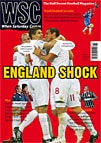 Numbers matter to the supporters of Brazil's biggest club sides but the figures don't always add up. Robert Shaw reports
Numbers matter to the supporters of Brazil's biggest club sides but the figures don't always add up. Robert Shaw reports
Flamengo are seen by many as Brazil’s Manchester United – at least when it comes to support, if not titles. Size matters to their fans who proclaim themselves the biggest such group in the world (Maior do Mundo) by draping a large banner to that effect at all Flamengo games in the Maracanã. In a country where the away support for Serie A clubs hardly goes beyond a couple of coach-loads Flamengo routinely manage to compete with, if not outnumber, the home turn-out.
But the club’s status within Brazil was questioned recently by their former striker Ronaldo. He had been expected to wind down his career at the club where he made his name but opted to join Corinthians of São Paulo instead.
On a recent TV show he sniped: “I learnt at Corinthians that these surveys about Flamengo are wrong. They take the fans from other states who have Flamengo as their second team.” Journalist Juca Kfouri has since suggested that in one respect Ronaldo is right. “He was joking but still told the truth: Corinthians have more fans in São Paulo than Flamengo have in Rio. And São Paulo is the principal market .”
Evidence of this was provided in early August when Goiás coach Hélio dos Anjos slammed local supporters who cheered for Flamengo: “You have people invading the pitch to snap photos with the away team. But Flamengo fans from here are my enemy.” As it turned out there was no trouble between the two sets of fans during the hosts’ 3-2 win, although the comments were widely condemned in the Brazilian media.
Most surveys acknowledge that Flamengo have the numerical edge. Research conducted in 2007 and 2008 among 11,786 people across 25 Brazilian states showed Flamengo with 17 per cent of the vote, while Corinthians were second with 12 per cent.
Some question the conventional wisdom that Flamengo have around 35 million fans. An executive from the Globo sports media group argues that Flamengo and other clubs habitually “stretch” the figures to help them negotiate better slices of broadcasting revenue and sponsorship deals. Globo used to dread the relegation of a big club to Serie B due to its impact on audiences. A series of major clubs have fallen into the second tier since 2002, but it appears that the broadcaster now welcomes this as a way of driving sales of pay-per-view packages for games in Serie B.
The figures also mask the fact that many are “passive” fans – nominal “red-and-blacks” weaned on a regular diet of Flamengo games broadcast to the furthest outposts of the country. América of Rio de Janeiro are widely perceived to be many supporters’ second club but as Kfouri suggests it is more accurate to call these fans “sympathisers”. With more genuine supporters América would probably not be relying on a 43-year-old Romário to dig them out the second division of the Rio state league.
According to some, how much the supporters spend is more important than overall numbers. In this respect Flamengo have been left behind by the marketing drives of Internacional and their Porto Alegre rivals Grêmio. Inter have set themselves a target of 100,000 club members with the books being balanced by selling a couple of players to Europe each year. São Paulo, meanwhile, currently generate the highest revenue of any Brazilian club, through a combination of astute financial policies and recent success nationally and internationally. “In reality there are only four genuinely national clubs: Flamengo, Corinthians, São Paulo and Vasco,” suggests Kfouri.
Adriano’s return to Flamengo attracted 67,000 but was topped on August 22 when Vasco upstaged their local rivals by pulling in 80,000 to watch a Serie B game in the Maracanã – the highest gate in 2009. Meanwhile, Ronaldo’s Corinthians were recently thrashed 4-1 at home by Goiás, who moved into the top four in Serie A. This prompted another outburst about Goiás supporters, this time from their striker Iarley: “The majority of Goianos are against us. When the team is doing well nothing happens. When it’s bad they appear, to stir things up.”
From WSC 273 November 2009